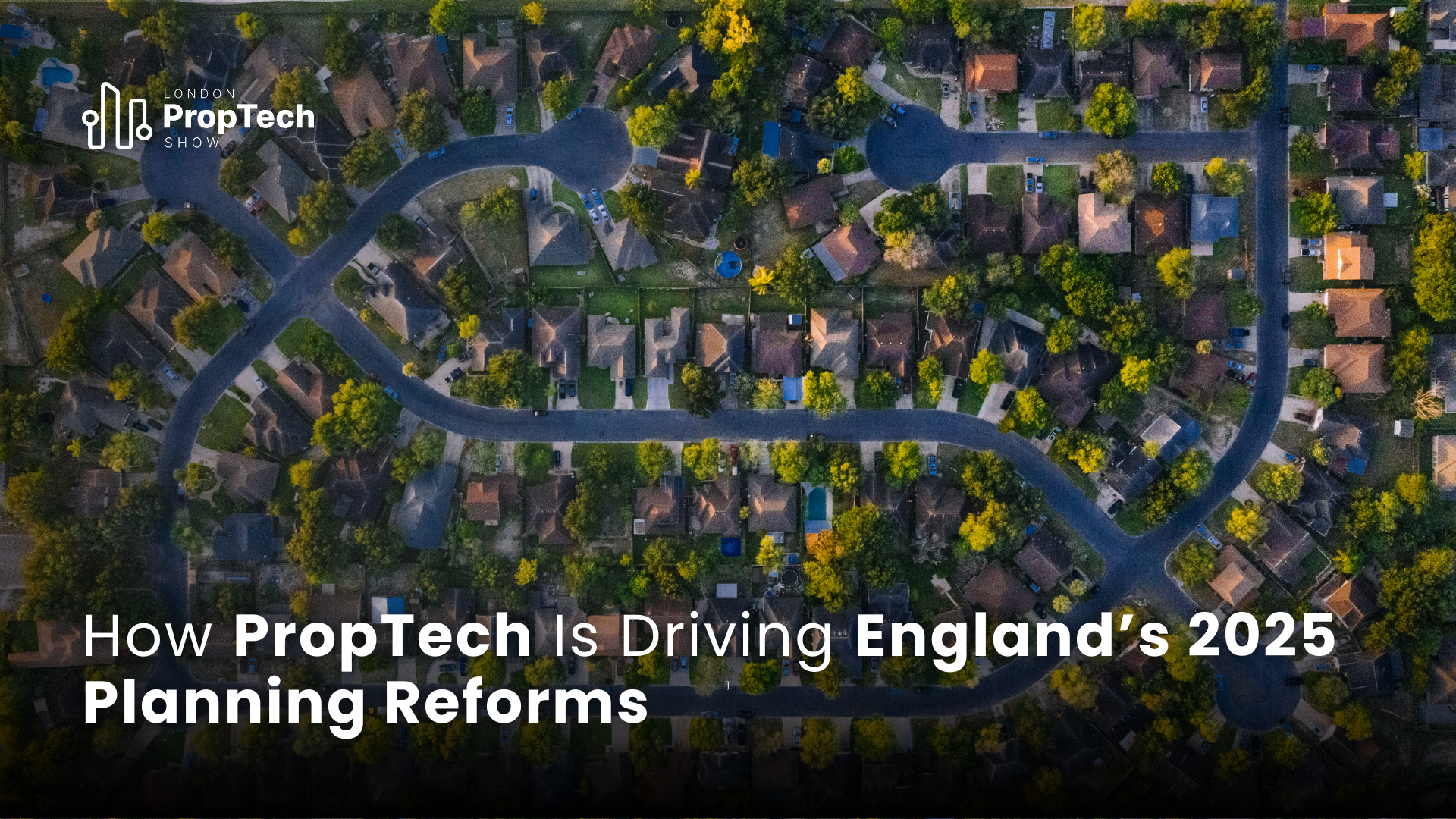England’s 2025 planning reforms are not simply being enabled by digital solutions, they are being fundamentally shaped and propelled by the adoption and integration of PropTech. No longer a sideline player, property technology is at the core of a new era in planning, underpinning strategies for efficiency, transparency, collaboration, and speed in the delivery of homes and infrastructure. From AI-driven compliance checks to cloud collaboration, PropTech innovations are aligning with and sometimes outpacing policy, helping England reach its ambitious goal to build 1.5 million new homes while accelerating environmental progress and economic growth.
This blog explores, section by section, how PropTech is not just responding to reform but driving the direction, implementation, and outcomes of England’s evolving planning landscape.
Planning & Infrastructure Bill: PropTech as the Accelerator
At the heart of the 2025 reforms is the Planning and Infrastructure Bill, a legislative push to modernise planning, remove bottlenecks, and streamline delivery of major infrastructure projects. PropTech is playing a central role in transforming these ambitions into tangible outcomes.
- Automated Submissions and Digital Portals: Online platforms now allow for rapid applications, compliance reviews, and tracking of Nationally Significant Infrastructure Projects (NSIPs). AI algorithms highlight risks and suggest pre-emptive solutions, reducing human error and boosting decision-making speed.
- Reducing Legal Delays: The ability to instantly access, audit, and share records through secure PropTech platforms reduces costly and time-consuming judicial reviews.
- Environmental Delivery Plans (EDPs): PropTech makes the government’s nature strategies scalable, using GIS, sensors, and big-data analytics for monitoring, reporting, and demonstrating net gain. Environmental overlays in site selection tools help local authorities and developers visualise and quantify impact before a spade hits the ground.
These digital foundations make the Bill’s goals of faster homes, smarter infrastructure, safeguarded nature realistic and measurable.
NDMPs, the NPPF, and Standardised, Digital-First Planning
The introduction of National Development Management Policies (NDMPs) and updates to the National Planning Policy Framework (NPPF) offer the potential for national consistency and clarity. PropTech is actively shaping the shift from paper and PDF to centralised, digital-first frameworks.
- Unified Data Platforms: Cloud repositories now allow both government and private planning teams to access, update, and version control policies in real-time. This flattens regional inconsistencies and embeds transparency in day-to-day workflows.
- Compliance and AI: Automated policy-checking tools cross-examine local submissions against the NDMP and NPPF, raising red flags and providing guidance before applications reach decision-makers, saving time and money.
- Strategic Analytics: PropTech dashboards provide instant insight into policy compliance, housing delivery and environmental net gain, equipping planners, councillors, and citizens with the data needed for smarter debate and decision-making.
By building digital architecture alongside new policy, PropTech is setting new standards for clarity, adaptability, and responsiveness.
Meeting Tight Timelines: PropTech’s Power in Local Plans
The Levelling Up and Regeneration Act 2023 compresses the statutory local plan preparation timeline from 42 to just 30 months, a challenge that cannot be realistically met without the transformative effect of PropTech.
- Collaborative Drafting: Cloud-based drafting tools, real-time commenting, and automated reporting streamline stakeholder engagement and evidence assembly, making plan production possible within sharply reduced timeframes.
- Digital Consultation: Virtual exhibition rooms, interactive maps, and online surveys increase both the volume and geographic diversity of public input, leading to plans that reflect genuine need and support.
- Data Reuse and Automation: Platforms that dynamically link datasets like transport, utilities, biodiversity reduce human error and administrative duplication while surfacing new opportunities for resource sharing.
Digital solution providers are thus turning a potential implementation bottleneck into a showcase of what rapid, consultative, evidence-based local planning can look like setting new benchmarks for speed and public trust.
Unlocking Land and Value: PropTech-Enabled Site Analysis
'Grey belt' reviews and Green Belt funding to local authorities have catalysed a new wave of PropTech adoption in land analysis and site promotion.
- Remote Surveys and Drones: Capabilities once exclusive to major engineering firms are now mainstream, allowing even small councils to rapidly assess site suitability and risks.
- Spatial Data and Environmental Layers: Dynamic GIS dashboards allow planners to overlay policy, environment, accessibility, and infrastructure constraints rapidly surfacing ‘win-win’ sites ready for unlocking.
- Public-Facing Maps: When controversial decisions need clear communication, interactive PropTech map layers make it simple for all citizens to see the evidence.
These solutions empower faster, more transparent land decisions, accelerating both housing and environmental targets.
Managing Governance Complexity: PropTech Bridges the Gap
As devolution, combined authority overlays, and local government reorganisation create new layers and transitions, PropTech keeps planning streamlined and consistent.
- Digital Workflow Automation: Platforms track application progress as responsibilities move between authorities, ensuring no project slips through the cracks during handovers.
- Access Control and Secure Exchange: Data-sharing protocols mean sensitive information, from confidential land deals to viability appraisals, can be shared only with those who need access, ensuring compliance with privacy and governance requirements.
With PropTech underpinning cross-boundary planning, institutional churn no longer means procedural chaos; instead, it’s managed transition.
Environmental Strategy and Net Gain: Data, Tech, and Accountability
New strategic environmental mechanisms such as the Nature Restoration Fund, Environmental Delivery Plans, and Local Nature Recovery Strategies (LNRS) depend on robust data collection, aggregation, and visualization.
- Automated Monitoring: PropTech now enables continuous, tamper-proof biodiversity and habitat monitoring, forming the backbone of net gain evidence required for planning consent.
- Integrated Reporting: Digital platforms aggregate data from multiple schemes and locations into unified dashboards, equipping both local and central government to monitor and direct investments to areas of greatest environmental need.
- Resilience and Modelling: Flood risk, heat islands, green corridors algorithms can now simulate, test, and optimise interventions before they are delivered on the ground.
This transition from labour-intensive, fragmented paper-chasing to a data-rich, digital-first environmental system is a leap forward in achieving both housing delivery and natural capital goals.
Approval Workflows and Consent Variation: Going Digital-First
The reformed Section 73B process for consent amendments is perfectly suited for PropTech:
- Version Control with Audit Trails: Digital tools manage approvals, comments, and document changes with full transparency.
- Prompt Regulatory Checks: Automated flagging of “substantial difference” criteria speeds up decision-making on whether a variation requires a fresh planning application.
- Stakeholder Collaboration: Multi-stakeholder collaboration in one secure environment increases certainty and speed for all parties.
New Towns & Digital Masterplanning: PropTech at the Centre
With the New Towns Taskforce set to announce new sites, PropTech is driving masterplanning to a new level:
- Digital Twins & Scenario Modelling: The use of digital twins and BI modelling allows teams to trial infrastructure and design with precision before committing capital.
- Integrated Data-Driven Delivery: From utilities phasing to net-zero energy modelling, PropTech solutions ensure holistic, future-ready communities that can adapt with data.
The PropTech Ecosystem: Collaboration, Awareness & Policy
The government’s 2025 reforms coincide with a £1.2 million PropTech Innovation Fund, strategic partnerships between tech suppliers, public sector, and investors, as well as dedicated roadshows and working groups. These initiatives are not bystanders they are designed to:
- Accelerate tech adoption through targeted pilots and funding
- Build industry awareness of new tools and techniques
- Provide policy recommendations that support the scaling of PropTech in public and private sector processes
PropTech is now a strategic partner in delivering the reforms, as much a stakeholder in the future of planning as the government and developers themselves.
Conclusion: PropTech as the Strategic Engine for England’s Planning Future
The story of England’s 2025 planning reforms is, in large part, the story of PropTech: a sector that transitioned from the sidelines to the centre, driving faster, fairer, and more sustainable outcomes. With every legislative shift, digital platform, and real-time dashboard, PropTech is reimagining how the built and natural environment of England is shaped.
By embedding digital collaboration, data science, automation, and public engagement at every level, PropTech propels England toward a planning system fit for the twenty-first century: responsive, efficient, and fully aligned with national ambitions on growth, sustainability, and digital innovation.


